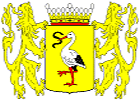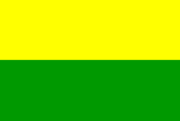The Hague
|
|
- This article is about the city in the Netherlands; there is also a region known as (the) Hague in France.
Template:Infobox Dutch municipality 3
The Hague (with capital T; Dutch: Den Haag, or officially 's-Gravenhage) is the administrative capital of the Netherlands, located in the west of the country, in the province South Holland of which it is also the capital. With a population of 469,568 (01-01-2004) (700,000 in the metropolitan area) and an area of approximately 100 km², it is the third-largest city in the Netherlands after Amsterdam and Rotterdam.
The Hague hosts the Eerste Kamer and the Tweede Kamer, respectively the Senate and the House of Representatives, forming the Dutch parliament. Also the Dutch Queen Beatrix lives and works in The Hague. All foreign embassies and government ministries are located in the city, as well as the Supreme Court and many lobby organisations. Nevertheless, Amsterdam is the official capital of The Netherlands, as is stated in the Dutch constitution.
As one of the capitals of the United Nations, The Hague is host to several institutions of the UN:
- The International Court of Justice, located in the Peace Palace (Vredespaleis, its construction was financed by Andrew Carnegie).
- The International Criminal Tribunal for the Former Yugoslavia.
- The International Criminal Court.
- The Organisation for the Prohibition of Chemical Weapons.
- The Model United Nations
In addition, the Hague Academy of International Law is also located in the city.
| Contents |
History
Binnenhof.jpg
Later, the counts of Holland used The Hague as their administrative center. 'Des Graven Hage' literally means "The counts' hedge" or "The count's private enclosure". The powerful cities of Holland, like Leiden, Delft and Dordrecht compromised to choose the then small and unimportant The Hague as their administrative center. This policy was never changed and therefore The Hague is to this day the center of government but not the official capital.
To keep The Hague small it was not allowed city rights or allowed to build city walls. When city walls were finally allowed in the 1500s, the population decided to use the money to build a city hall instead of city walls. This proved disastrous during the Eighty Years War, as it allowed the Spanish troops to easily occupy the town.
The Hague was finally named a city by the French occupation force in 1806, centuries after other Dutch cities had received similar rights. All this has led to the urban legend that The Hague is not a city but a village.
Because of its history it lacks a large historical inner city like the nearby cities of Leiden and Delft. But when the government started playing a more prominent role in Dutch society after 1850, The Hague quickly expanded. The older parts of the city are therefore mostly from the 19th century and the early 20th century.
The city sustained heavy damage during World War II. The Atlantic Wall was built right through the city, causing whole neighbourhoods to be torn down by the Germans. On March 3rd, 1945, the Royal Air Force bombed the Bezuidenhout. The target was an installation of V-2 rockets in a nearby park. Due to navigation errors, the bombs fell on a heavily populated part of the city. Over 500 people died and the scars in the city can still be seen today.
After the war The Hague was at some point the largest building site in Europe. The city expanded massively in the southwest. The destroyed areas were also quickly rebuilt. The population peaked at 550.000 inhabitants around 1970.
In the 1970s and 1980s the mostly white middle classes moved to the suburbs like Voorburg, Leidschendam, Rijswijk and most of all Zoetermeer. This led to the traditional pattern of an impoverished inner city and more prosperous suburbs. Attempts to include parts of the suburbs in The Hague were highly controversial. In the 1990s, after consent of Dutch Parliament, The Hague did succeed in annexing fairly large areas from its neighboring towns on which complete new residential areas were built and are still being built.
The stork is the symbol of Den Haag.
Royalty: William V (stadtholder), William I (king), William II (king), Wilhelmina and Juliana were born in The Hague.
The city
Thehague_4.jpg
Its location makes it the largest Dutch city by the North Sea. The Hague comprises two distinct beach towns. The main beach resort Scheveningen, in the northwestern part of the city, is a popular destination for tourists and young people to go out. With 10 million visitors a year it is the most popular beach town in the Benelux. It's perhaps for this reason that many people, even Dutch, mistakenly believe Scheveningen is a city in its own right. That is not the case: Scheveningen is one of The Hague's eight districts ("stadsdelen"). Kijkduin is the other beach resort of The Hague, in the southwest, a lot smaller and attracting mainly local people.
The former Dutch colony of Netherlands East Indies ("Nederlands-Indië", nowadays called Indonesia) has left its mark on The Hague. Many streets are named after places in Netherlands East Indies and there is a sizable "Indische(e)" or "Indo" (i.e. mixed Dutch-Indonesian) community. After the loss of these Dutch possessions in December 1949, "Indisch(e)" or "Indo" people often refer to The Hague as 'the Widow of "Indië"'.
Den_Haag_stadhuis_april_2004.JPG
You can find some of the most prosperous and some of the poorest neighbourhoods of The Netherlands in The Hague. The wealthier areas are generally located west of the Laan van Meerdervoort. The poorer areas can be found in the southern and eastern parts of the city. This division is reflected in the local accent. The more affluent citizens are usually called "Hagenaars" and speak so-called "bekakt" (Dutch for 'that which has been shit upon') This is contrasted with the "Hagenezen", who speak "plat Haags". There is relatively little social interaction between these groups.
Business
Professional life in the city is dominated by the large number of civil servants working. Government ministries and public organisations are almost all located in The Hague. Added to that several large businesses have their headquarters in The Hague.
- Royal Dutch Shell, one of the largest companies in the world
- KPN, the Dutch national phone company
- AEGON, one of the largest Dutch insurance companies
- TPG, large international provider of post and logistics services
There has never been a large industrial base in The Hague, with perhaps the exception of the fishing harbour of Scheveningen.
Culture
The Hague does not have a reputation for a bustling night life. What night life there is centres around the luxurious Pathé Buitenhof cinema and a handful of bars and restaurants in its immediate vicinity. A similar pattern of night life centering around a cinema is present in Scheveningen. The Hague does however have its share of good museums and cultural institutions.
- Madurodam is a miniature city in The Hague, which reflects what the Netherlands look like.
- The Mauritshuis exhibits many paintings by Johannes Vermeer, Rembrandt van Rijn and Paulus Potter.
- The Royal Theatre and the Nationaal Toneel-group are located at the Korte Voorhout.
- The Gemeentemuseum hosts a large collection of images from the Dutch painter Piet Mondriaan as well as other modern art.
- The Escher Museum is located in the former Royal Palace at the Lange Voorhout.
- Famous writers from The Hague include Remco Campert, Simon Carmiggelt, Louis Couperus and poet Bart Chabot.
- Panorama Mesdag houses a cylindrical 'panoramic' painting of 14 meter high x 120 meter long, depicting The Hague and Scheveningen in the 19th century, made by Hendrik Willem Mesdag. It is presented in such a way that it is almost as if one is looking at a real scene instead of a painting.
- The museum Beelden aan Zee has a large collection of sculptures, mainly from 20th-century artists.
- The Museon is a science museum.
- The Congresgebouw hosts the annual North Sea Jazz Festival. However, the festival organisation intends to move to Rotterdam in the near future.
- The Hague has brought forth the rock bands Shocking Blue and Golden Earring and the satiricists Kees van Kooten and Wim de Bie.
- Lucent Theatre hosts celebrated Nederlands Dans Theatre, or the NDT, a modern dance company. The building of NDT was designed by the Dutch architect Rem Koolhaas in 1988.
Sport
The local football club is called ADO Den Haag.
Famous sportsmen from The Hague include:
- 1996 Wimbledon Champion Richard Krajicek
- The twice former coach of the Dutch national football (soccer) team, Dick Advocaat
- Joop Zoetemelk. The best Dutch cyclist ever. He won the Tour de France in 1980 and finished second in the Tour six times.
- Four times Embassy / Lakeside Darts champion Raymond van Barneveld
- 1992 Olympic Champion (10 km speed skating) Bart Veldkamp
- 1964 Olympic Champion (swimming) and current President of the Netherlands Olympic Committee Erica Terpstra
- Peter Blangé. One of the leading players of the Dutch volleyball team that won the gold medal at the 1996 Olympic Games in Atlanta.
- Jan Hein Donner. A flamboyant chess grandmaster, who won the Dutch championship several times. He was among the world's best in the 1960s.
Annual events
- August: HaSchiBa - multicultural festival
- Summer: series of weekly fireworks, and in one week a fireworks festival
Transportation
Public transportation in The Hague consists of a sizeable number of tram- and buslines, operated by the Haagsche Tramwegmaatschappij, or HTM. Plans for a subway were shelved in the early 1970s. However, since 2004 there is a tunnel with two underground tram stations (Spui and Grote Markt) in the city centre; it is shared by tram lines 2, 3 and 6.
A light rail system called Randstadrail [1] (http://www.randstadrail.nl) is under construction, connecting The Hague, Rotterdam, Zoetermeer and suburbs.
There are two main train stations: Den Haag Hollands Spoor (gv) and Den Haag Centraal (gvc). It is somewhat confusing that many trains bypass the central station; this is because it is a terminus. The Thalys Paris - Amsterdam stops at Den Haag Hollands Spoor. Central Station connects The Hague to every major city in The Netherlands, often with direct train connections.
The nearest airport is Rotterdam Airport, but it is not easy to reach by public transport. With four trains per hour going directly from Hollands Spoor or Centraal to Amsterdam Schiphol Airport, most travellers for The Hague fly to Schiphol.
Major highways near The Hague are the A12 (which also was the first highway in The Netherlands), running to Utrecht and further to the border with Germany and the A4, connecting Amsterdam, The Hague and Rotterdam with the Belgian cities of Antwerp and Brussels.
Population
1796: 41,300 inhabitants
1830: 56,100
1849: 63,600
1879: 113,500
1899: 206,000
1925: 394,500
1970: 550,000
1990: 441,327
2000: 441,097
2004: 469,568
Subdivisions
|
The Hague has eight official parts (stadsdelen)[2] (http://www.denhaag.nl/smartsite.html?id=22281):
|
|
Nearby towns
External links
Template:CommonsTemplate:Commons
- City of Den Haag (http://www.denhaag.nl/)
- City of Den Haag (http://www.thehague.nl/)
- "About The Hague" (http://home-2.worldonline.nl/~aarde01/)
- Panorama Mesdag (http://www.panorama-mesdag.nl/index.php?page=/home_nl.php#)
- Gemeentemuseum (http://www.gemeentemuseum.nl/)
- Haagsche Courant. Local newspaper (http://www.haagschecourant.nl/)
- De Digitale Hofstad. Off-beat news about The Hague (http://www.denhaag.org/)
- HTM map (http://www.htm.net/smartsite.dws?goto=1694)
- The Hague Hotel Guide (http://www.the-hague.info/)
- For some edges of The Hague see the detailed maps of Rijswijk [3] (http://www.plattegronden.nl/rijswijk/), Leidschendam-Voorburg [4] (http://www.plattegronden.nl/gemeentevoorburg-leidschendam/index.html) and Wassenaar [5] (http://www.plattegronden.nl/wassenaar/).
Template:Province South Holland 4paf:Den Haag da:Haag de:Den Haag et:Haag es:La Haya eo:Hago fr:La Haye ko:헤이그 id:Den Haag he:האג la:Haga li:D'n Haog nl:Den Haag ja:ハーグ no:Haag pl:Haga pt:A Haia ro:Haga fi:Haag sv:Haag zh:海牙



